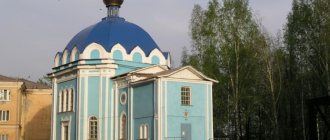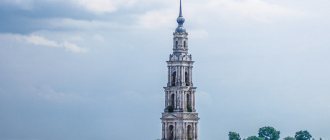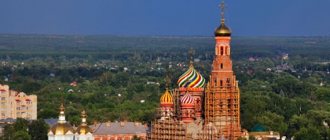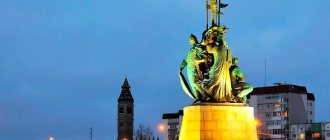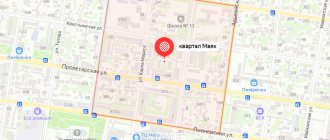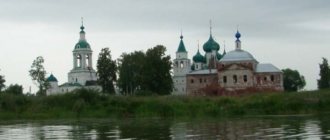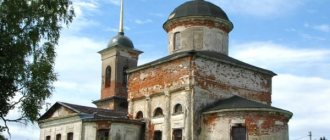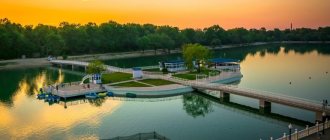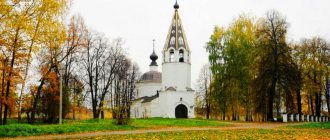We continue to talk about the cities of the Moscow region. Today, next in line is Dmitrov , founded by Prince Yuri Dolgoruky in 1154. Dmitrov was named after the youngest son of Yuri Dolgoruky - Vsevolod the Big Nest (at baptism he received his second name - Dmitry), who was born in the same 1154. During its history, the city was part of the Pereyaslavl Principality, the Vladimir-Suzdal Principality, the Galicia-Dmitrov Principality, the Dmitrov Principality and, finally, the Moscow Principality. On the way of the Mongol-Tatar raids on Rus', Dmitrov was defeated and burned several times. Now 66 thousand people live in Dmitrov, for the 850th anniversary of the city (by 2004) a large-scale improvement project was carried out for the city, in 2008 the city was awarded the title “City of Military Glory”. The Dmitrov Kremlin and the Boris and Gleb Monastery are the main one-day tourist routes.
Dmitrov Kremlin
The Dmitrov Kremlin was built in the 12th century as an ancient Russian border fortress. Nowadays there is a museum-reserve on this site, which includes 12 buildings (six of which are located on the historical square). The museum's fund includes about 40 thousand storage units.
Dmitrov's Zemlyanoy Val
The museum gates are open from 10 am to 5 pm; Closed: Monday and Tuesday. But even if you arrive outside of working hours, do not despair, because the entire territory of the Kremlin can be viewed from the once defensive embankments of the 12th century, closed around the Kremlin. The total length of the shafts is 990 meters, and the maximum height is 14 meters. Once on the ramparts there were wooden walls and towers of the Kremlin, which were not preserved due to frequent wars and fires. The Kremlin's earthen rampart is protected by the state.
Alexander Chapel
Or the chapel of Alexander Nevsky, the patron saint of all warriors. It was built in 1868 at the expense of the townspeople in honor of saving the life of Emperor Alexander II from an assassination attempt in 1866. The chapel is installed outside the Kremlin, in front of the Nikolsky Gate.
Nikolsky Gate
Nikolsky Gate (travel Nikolskaya Tower), was considered the main entrance to the Dmitrov Fortress from the north-western side and was burned in 1610 during the Time of Troubles, like the other 9 towers with a defensive wooden wall. The current wooden Nikolsky Gate was built in 2004, after which it burned and was restored several times.
Assumption Cathedral in Dmitrov
The architectural dominant of the Dmitrov Kremlin is the Assumption Cathedral. The cathedral was rebuilt several times, as a result of which it received 9 chapters (initially there were 5). The exact date of construction of the cathedral is unknown, approximately between 1509 and 1533. From 1932 to 1991 the temple was closed and transferred to the museum, the crosses were removed and the dome and spire of the bell tower were dismantled. In 2003, the temple and bell tower were completely restored and restored.
Gilded five-tiered iconostasis from the late 17th century.
Walking path from St. Nicholas Gate to the Assumption Cathedral.
In 2010, in front of the entrance to the Assumption Cathedral, a monument was erected to the Holy Martyr Seraphim, Bishop of Dmitrov. Bishop Seraphim served in the Assumption Cathedral of Dmitrov from 1920 to 1923. During this time, he founded the Brotherhood of the Life-Giving Cross of the Lord and was engaged in counter-revolutionary activities, for which he was sent into exile, and on August 23, 1937 he was sentenced to death.
A monument to the brothers Cyril and Methodius, who are known as the creators of the Slavic alphabet, was erected here in 2004. Cyril is holding a scroll with the Cyrillic alphabet in his hands, and Methodius is holding the Gospel.
Their image can also be seen inside the Assumption Cathedral on the wall.
Assembly of the Nobility
The building was built between 1877 and 1888. to accommodate military units stationed in the city. It became the building of the noble assembly a little later: in 1897. After the revolution of 1917, party and public organizations began to be located here: the Red Army club of the Dmitrov garrison named after Semenyuk, the party club, library and circles. After a fire in 1921, the second floor completely burned down, which was restored only in 2003. All this time, the remaining first floor was used as a school, workshops, and warehouses, until it fell into disrepair. Now the restored building is used by the museum to house art exhibitions.
Elizabethan Church
The Church of St. Elizabeth was built in 1898 and was assigned to the city prison, which is why the windows were reinforced with metal bars, and there was a balcony for guards on the second floor. Elizaveta Semyonovna Lyamina (wife of the owner of the Yakhroma spinning and weaving factory) donated funds for the construction of the church. In 1925 the church was closed and used as a village club and then as a storage building. In 1998, the church was returned to the Orthodox Church.
Prison building and outbuilding
The prison for which the Elizabethan Church was built is located right there (pictured in the center). The building was built at the beginning of the 19th century and served as a prison until the beginning of the 20th century. Later, the building housed: an improvement plant of the Executive Committee of the City Council, a funeral supplies store, and a laundry collection point. In the early 1980s. the building was transferred to the museum.
The outbuilding (two one-story extensions on the sides of the prison) was used as administrative buildings for the prison. Later the premises were converted into apartments for prison servants. Now the buildings have also been transferred to the museum, where museum funds are stored.
Gymnasium
The women's gymnasium (4 junior classes) was built in 1876 on the orders of Emperor Alexander II; girls from the most noble families of Dmitrov studied there. Along with it, six more new gymnasiums were built in Dmitrov. After 30 years, the pro-gymnasium was transformed into a full gymnasium with an 8-year course of study. There were 198 girls in seven subject classes, eight additional and two parallel preparatory classes. The gymnasium was financed from the city budget.
Behind the gymnasium there is a streetball court.
Parochial school
A former parochial school, it now houses the “Russian House” center for the development of creativity for children and youth.
Dmitrov's story
People have long settled in these areas, as evidenced by numerous mounds, fortifications and sanctuaries. Dmitrov is not much younger than Moscow - Prince Yuri Dolgoruky founded it in 1154 on the site of an ancient Slavic settlement and named the city in honor of his son Vsevolod (baptized Dmitry) who was born that year. The location was chosen well: near the Yakhroma River, from where the trade route to the Volga went along Sestra and Dubna. Another, land route went to Klyazma, and from there to Vladimir.
In the 12th century, impenetrable forests and swamps began immediately behind Dmitrov. The city served as a northwestern outpost of the Vladimir-Suzdal principality and occupied an important strategic position, covering the road to Suzdal along the Vela and Dubna rivers.
Coat of arms of the city of Dmitrov
Dmitrov was ruined more than once - both by the Mongol-Tatars and by the appanage princes and relatives. To stop the civil strife, the Dmitrov Congress of Princes was convened here in 1301, which was attended by Grand Duke Andrei Alexandrovich of Vladimir (son of Alexander Nevsky), Prince of Tver Mikhail Yaroslavich (nephew of Alexander Nevsky), Prince of Moscow Daniil Alexandrovich (youngest son of Alexander Nevsky), Pereslavsky Prince Ivan Dmitrievich (grandson of Alexander Nevsky). However, the truce did not last long, and four years later the princes resumed the showdown.
The Dmitrov Congress of Princes was reflected in the city’s coat of arms, which Dmitrov received in 1781:
At the top of the shield is the Moscow coat of arms. At the bottom there are four Princely crowns, in an ermine field, in memory of the famous Four Russian Princes Congress that was held in that city.
— The Highest Decree of Empress Catherine II of December 20, 1781
In 1364, the Dmitrov Principality was annexed to Moscow. From that time on, it belonged to one of the younger brothers of the Moscow princes, who bore the title of princes of Dmitrov. The first prince who lived and died here was Peter (1389-1428), one of the younger sons of Dmitry Donskoy. At the end of the 14th – beginning of the 15th century, during the period of civil strife between Dmitry Shemyaka and Vasily Kosy with the Moscow prince Vasily II the Dark, the city repeatedly changed hands. The last prince of Dmitrov was Yuri, the second son of Ivan III.
Under Prince Yuri (ruled 1505-1533), Dmitrov reached his greatest prosperity. The Assumption Cathedral was erected in the Kremlin, and the Boris and Gleb Monastery was rebuilt in stone. An important trade route to the north ran from Moscow through Dmitrov, and the city grew rich.
Apollinary Vasnetsov. "Dmitrov in the 16th century"
In 1556, Ivan the Terrible exchanged Dmitrov for Staritsa from Prince Vladimir Andreevich Staritsky. After the execution of the latter in 1569, Dmitrov finally went to Moscow. The oprichnina almost completely devastated the city.
In January 1610, the troops of Jan Sapieha, who had retreated from the walls of the Trinity-Sergius Monastery, gained a foothold in Dmitrov. The ancient wooden Kremlin was burned, the city was depopulated. After the Time of Troubles, Dmitrov never achieved its previous level of prosperity, turning into a quiet merchant and craft town. In 1781 it received the status of a district town of the Moscow province, and in 1784 it received a regular development plan. The revival of trade contributed to the prosperity of the Dmitrov merchants. In the picturesque Dmitrovsky district, estates of the richest families in Russia are being built.
“Projected” plan of the city of Dmitrov in 1784 from the “Complete Collection of Laws of the Russian Empire. Book of drawings and drawings. City plans"
In September 1812, when Napoleon occupied Moscow, a French detachment settled in Dmitrov. However, having learned about the approach of the Russian army from Klin, he hastily left it.
After the construction of the Nikolaevskaya railway, which passed through Klin, and the Yaroslavl railway through Sergiev Posad, Dmitrov found himself somewhat aloof from traffic flows. River trade, which fed the city in the past, had by that time lost its relevance. In 1900, the Savelovskaya Railway passed through Dmitrov, thanks to which the city received a new impetus for development.
On August 11, 1918, in Dmitrovsky district there was an uprising of local residents against the additional seizure of food, which was brutally suppressed. The instigators were shot on Cathedral Square in Rogachevo. The ashes of the dead Red Army soldiers were transported to Dmitrov and buried in the park on Zagorskaya Street.
In 1932, construction of the Moscow-Volga Canal . The canal was built by prisoners from Dmitlag (a division of the Gulag) and civilians. The leadership of Dmitlag was located in the Dmitrov Boris and Gleb Monastery. Prisoner barracks stood along the entire length of the canal; The names of that time have survived to this day: 3rd section, 4th section, Pace, Competition and others. The canal and hydraulic structures were built almost by hand, without the use of special equipment. The section between Iksha and Dmitrov, which crosses the Klinsko-Dmitrovskaya ridge, turned out to be one of the most difficult, with a large number of locks concentrated here.
Excavation and transportation of soil, photo from the site www.moidmitrov.ru
The total number of Canal Army soldiers killed is still unknown; figures range from 0.7 to 1.5 million people. Nowadays, during construction along the canal, unmarked mass graves are often found. In 1937, many Dmitlag leaders, civilians and former prisoners were shot.
On April 17, 1937, the canal began to be filled with water. On May 1, the first flotilla of Volga ships arrived in Dmitrov. On July 15, permanent navigation began along the Moscow-Volga Canal.
Moscow Canal in Dmitrov
In November 1941, fascist German troops managed to break through the canal and gain a foothold on the dominant Peremilov heights near Dmitrov, from where they were driven out during fierce battles on November 29 - December 5. From here the counter-offensive of the Red Army began. In memory of those events, a memorial was created in 1966 at Peremilov Heights. To stop the enemy's advance, the canal's spillways were opened by December 1, 1941. A huge territory from Yakhroma to the Ivankovo Reservoir went under cold water, thereby stopping the enemy’s advance in this direction.
♦ On the subject: Wall of water: the Moscow Canal during the war
Memorial "Peremilovskaya Heights"
After the war, construction in Dmitrov continued. Over time, old attractions were restored and new ones appeared. And today Dmitrov has turned into one of the most comfortable cities in the Moscow region.
Monument to the holy noble princes Boris and Gleb near the Boris and Gleb Monastery
Sovetskaya Square (formerly Upper Trading Square)
In front of the Dmitrov Kremlin lies Sovetskaya Square with a small walking alley. The square was also called Upper Trade Square and Revolution Square. The square received its current name in the 1920s, in connection with the Council of Workers', Peasants' and Soldiers' Deputies located here, and then the District Council.
Along the street there are buildings with shops, trading houses and cafeterias. It is worth noting that the entire area around the Kremlin is kept in perfect order, all thanks to the reconstruction of the city for the 850th anniversary (by 2004). For some reason, in Russia, cities look good only on anniversaries or before important competitions. They worked so well on Dmitrov that in 2005 the city took first place in the All-Russian competition “The most comfortable city in Russia” in the category “Up to 100 thousand inhabitants.”
The square is decorated with several fountains; on holidays, a stage is immediately installed.
Monument to Yuri Dolgoruky in Dmitrov
The main attraction of Sovetskaya Square is the monument to Yuri Dolgoruky, the founder of the city. According to legend, the monument is located in the very place where Yuri was predicted the birth of his son, after which he ordered the foundation of a city on this land. The monument was erected in 2001 as part of the same preparations for the city’s anniversary. Yuri Dolgoruky is “standing” with his back to the southern entrance to the Kremlin. Initially, this entrance did not exist; it was cut at the end of the 19th century.
On the opposite side of Sovetskaya Square there is a monument to V.I. Lenin (installed in 1950). It’s funny that the two leaders look and point with their right hands at each other; this can only be seen in Dmitrov.
Ski resorts
The Klinsko-Dmitrovskaya ridge has long been a favorite of alpine skiing enthusiasts. In recent years, modern ski resorts equipped with the necessary infrastructure have been built here.
- Sports Park "Volen" (Yakhroma, Troitskaya St., 1)
- Ski resort Stepanovo (part of the Volen-Stepanovo complex)
- Sports resort "Sorochany" (village Kurovo, 68)
- Leonid Tyagachev Ski Club (Shukolovskaya Mountain, Dedenevo)
- Sports Park “Iksha” (Iksha, Tekhnologicheskaya St., 2)
I hope my small guide will help you navigate the sights of Dmitrov and its surroundings. I wish you pleasant trips through this beautiful region.
© Website “On the Roads of the Middle Way”, 2009-2021. Copying and reprinting of any materials and photographs from the site anashina.com in electronic publications and printed publications is prohibited.
Zagorskaya street in Dmitrov
An eternal flame burns not far from the southern entrance to the Kremlin. The Eternal Flame memorial was installed at the end of 2001 on the site where the T-34-85 tank previously stood (the tank has now been moved to the exit from the city). Traditionally, the names of those killed during the Great Patriotic War are carved on a granite pedestal.
A little further: a park with a fountain.
Across the road is a residential building with a drawing calling for peace among all peoples.
Zagorskaya Street leads directly to the main building of the Museum and Exhibition Complex, which includes the Dmitrov Kremlin. The building was opened in 2004 on the site of an ancient settlement. The building houses exhibition halls, fund storage facilities and administrative premises, circles and clubs.
There is also a walking park with fountains.
Zagorskaya Street ends with the Constellation Palace of Culture: a yellow building with columns in the style of Soviet neoclassicism. The building houses the municipal theater “Bigger Nest”, where author exhibitions, concerts, creative meetings, theatrical performances, official events and city holidays are held.
What to see in Dmitrov in one day
Which attractions in the city of Dmitrov can you visit in 1 day and what to see in its surroundings? First of all, this is its Kremlin and monuments of religious architecture!
- If you come to Dmitrov for one day, then the first attraction where you should start your trip is the city’s railway station, built in 1901.
- Further, moving along Vokzalnaya Street, you will come to a small square with a monument to the patron of the city, Dmitry Solunsky.
- After visiting the monument, turn left and walk towards the city center, where you will see the administration and the Lenin monument.
- Continuing in a straight line, you will find a monument to Yuri Dolgoruky, and even further the main attraction - the earthen Kremlin.
- On the territory of the Kremlin, you can see exhibitions in the buildings of public places and the noble assembly, and also visit the Assumption Cathedral and the Church of St. Elizabeth.
- After visiting the Dmitrov Kremlin, take a stroll along Kropotkinskaya Street, where there are many museums and exhibitions.
- After exploring the museums, walk along Semenyuk Street to Pushkin Street. Here you will see many unique architectural objects, such as the Fufaevs' house and the Trinity Church, built in the Baroque style.
- You can complete your tour by turning off Pushkin Street at the intersection of Minin and Zagorskaya streets.
- Along Minin Street you will reach the Boris and Gleb Monastery, and along Zagorskaya - to the mansions of Countess Malyutina and the Klyatovs.
Important!
The route is quite long, so make sure you have comfortable shoes in advance!
Kropotkinskaya street in Dmitrov
In 2003 (of course, for the 850th anniversary of Dmitrov), the pedestrian part of Kropotkinskaya Street on the eastern side of the Kremlin was improved: paved, houses were restored, lawns were tidied up, sculptures and monuments were installed.
View of Kropotkinskaya Street from the embankment.
At the very beginning of the street there is a monument to Peter Alekseevich Kropotkin (1842-1921), a Russian prince, scientist and revolutionary. P. A. Kropotkin was a researcher of the tectonic structure of Siberia and Central Asia. Famous historian, philosopher and publicist, creator of the ideology of anarcho-communism and one of the most influential theorists of anarchism. Behind him is the house of the merchant Novoselov . The Novoselov family was the most numerous in Dmitrov; it dates back to the 17th century, and by the end of the 19th century more than 10 Novoselov dynasties already lived in Dmitrov. Such a large family occupied several houses on the street, but to this day only one house, built in 1842, has survived.
The remaining sculptures on Kropotkinskaya Street are not tied to any individuals; they are designed to reflect the life and way of life of the city in the 19th century. A couple of young nobles walking along the Kremlin. By the way, here is the third (eastern) entrance to the Dmitrov Kremlin. When the Yegoryevskaya Tower passage stood at this place.
A merchant with a merchant's wife. The merchant has in his hand a wonder of that time - a watch.
Female teacher with magazines and ruler.
Bearded pilgrim with a staff.
Peasant woman with a cat.
If you have time, check out the “Tourist's Dream” gallery on the same street. In fact, this is a store, but also a free museum of various gizmos. Here you can see original works (dolls, interior decorations, dishes, etc.) made by masters of the Dmitrov region; exhibitions of collectors, artists and textile workers. You can also order a guide around the city or a master class (of course, for a fee).
Chess: red pieces are Rus', and black pieces are Tatar-Mangols.
Sights of the city of Dmitrov (Moscow region) with photos and descriptions
The city of Dmitrov, located in the Moscow region, is an unusually rich point in the Golden Ring of Russia. The monuments of this city, which is often called “Moscow’s younger brother,” seem to have absorbed the entire history of the Russian state and are happy to tell it to tourists.
Dmitrov Kremlin
Dmitrov Kremlin
The main attraction of Dmitrov dates back to the middle of the 12th century. Throughout history, this defensive structure was destroyed seven times by opposing princes and Mongol khans. The last time the wooden fortress was burned by Polish-Lithuanian troops was in 1610 during the war of the Time of Troubles. After this, the fortification was no longer restored as it lost its military significance. Today, the defensive structures of the Dmitrov Kremlin are represented only by earthen ramparts. But inside there is a whole complex of architectural objects:
- Assumption Cathedral
- Elizabethan Church
- noble assembly;
- former prison;
- office building;
- museum lounge;
- women's gymnasium;
- Alexander Chapel;
- outbuilding;
- bridge of “happiness”;
- Nikolsky Gate;
- stone of "wishes".
The entire architectural complex of the Dmitrov Kremlin constitutes a unique museum-reserve.
Important!
The museum is open daily from 9:00 to 17:00 except Monday and Tuesday, as well as the last Wednesday of the month.
Religious buildings
Boris and Gleb Monastery
Unfortunately, many of the early buildings of Dmitrov’s religious architecture were destroyed by the Mongol-Tatar invasion in 1408. Only churches erected during the period of greatest development of the city during the reign of Ivan III’s son Prince Yuri in 1505-1533 have survived to this day. and later times.
- Borisoglebsky Monastery is a men's monastery in the city of Dmitrov. On its territory there is the Cathedral of Saints Boris and Gleb, which houses the relics of many devotees of the faith and a piece of the Holy Cross. In addition, on the territory of the monastery, which is one of the places of pilgrimage, there is St. Nicholas Church and the Chapel of the Holy Spirit. This holy place is best visited in late spring, when it is simply surrounded by green trees.
- Sretenskaya Church is a temple erected in 1814 at the expense of Dmitrov merchants Ivan Bolshakov and Boris Korovayev in honor of the victory over Napoleon. The building is made in the style of early classicism and painted in white and pink colors. Unfortunately, the interior decoration was lost during the Soviet years, when the church was used as a warehouse, and was restored only with the opening of the parish in 1992.
- The Vvedensky Church is an ancient church, the first mention of which dates back to 1625, and was previously wooden. The new stone structure was erected at the expense of merchants Tolchenov and Makarov in the second half of the 18th century. During Soviet times, the parish was not closed, but valuable church utensils were lost.
Other temples of Dmitrov:
- Assumption Cathedral;
- Trinity-Tikhvin Church;
- Kazan Temple;
- Elizabethan Church.
Monuments to Dmitrov
Monument to Boris and Gleb
Dmitrov’s sculptures depict both legendary personalities and ordinary residents of the city of different eras, professions and classes. They seem to have been introducing tourists to their daily lives for centuries.
- Yuri Dolgoruky - a bronze monument to the founder of the city was opened in 2001 according to the design of sculptor Vadim Mikhailovich Tserkovnikov. According to legend, it was installed on the spot where the prince was predicted to have a son, for whom he founded this city.
- The monument to Cyril and Methodius was erected near the Assumption Cathedral. In their hands, these holy enlighteners hold a book and a scroll with the Cyrillic alphabet. The author of the sculpture is A. I. Rukavishnikov, the project was led by the architect R. V. Narsky.
- A memorial sign to participants in wars and local conflicts is a granite pyramid in a public garden next to the Boris and Gleb Monastery. The monument is dedicated to the city residents who died in the wars, and there is a medal on each side.
- The Monument to Boris and Gleb is a monument opened in 2006 to mark the 600th anniversary of the local men’s monastery. The saints are depicted on horseback, wearing military clothing and holding weapons. Today this sculpture is one of the most beautiful sights of the city.
Most of the sculptures dedicated to ordinary townspeople were installed in 2003 on Kropotkinskaya Street. The best ones:
- summer resident with a cat;
- teacher;
- merchant and merchant's wife;
- young nobles;
- pilgrim.
City museums
Museum of Local Lore
The best way to learn the history of a city is in its museums. The most interesting museums in Dmitrov for tourists:
- The local history museum of the city of Dmitrov was opened in 1918 thanks to the initiative of the local intelligentsia. Through the efforts of its first leader, Academician M.N. Tikhomirov, unique exhibits have been collected here since 1920, telling the history of the region from ancient times to the present day. Tourists are interested not only in the museum’s collections, but also in its building, made in the Baroque style and decorated with a semicircular ring with columns.
- The Dmitrov Kremlin is a museum-reserve created in 1915. On the territory of the Kremlin there are several exhibitions that introduce tourists to the history of this architectural complex, Dmitrov’s noble estates, agriculture and traditional crafts of the region.
- The Box of Times is an interactive museum in the house where those evicted lived in the 1930s. from Moscow, princes Golitsyn. It was founded in 2014 and is especially popular among tourists with children.
Boris and Gleb Monastery
History has not preserved the exact date of creation of the Boris and Gleb Monastery; its oldest buildings date back to the 15th-16th centuries. The earliest mention of the monastery is indicated in the will of Prince Yuri Vasilyevich in 1472. The Boris and Gleb Monastery was repeatedly attributed to the composition of other monasteries. In 1682 they wanted to assign him to the Zaikonospassky Monastery, but the addition did not take place. From 1724 to 1726 was assigned to the Novgorod Bishops' House. Since 1764, the Boris and Gleb Monastery remains the only monastery in Dmitrov (Pyatnitsky and Nikitsky were abolished). Since 1926, the monastery has been closed and given to the local history museum. Since that time, the monastery has housed: a GULAG department for the construction of the Volga-Moscow canal, a military unit and various other organizations. Restoration of the monastery began in 1993; by 2004 it was completely restored and re-consecrated.
In 2006, a monument to princes Boris and Gleb was erected near the walls of the monastery - the first Russian saints, protectors of the Russian land and heavenly helpers of the Russian princes. Boris and Gleb were the sons of the Kyiv prince Vladimir Svyatoslavich (Vladimir the Red Sun), and were killed by their older brother Svyatopolk the Accursed.
The stone Cathedral of Boris and Gleb is the oldest building on the territory of the monastery and the center of the entire composition. In the 17th century, a three-tier hipped bell tower was added to it.
The Chapel of the Descent of the Holy Spirit was built next to the cathedral in 2004.
The Gateway Church of St. Nicholas was built under Archimandrite Kallistrat in 1685-1687 over the Holy Gates.
Abbot's house from the 19th century.
Monastic poultry house, also known as an aviary for peacocks. In the warm season, peacocks walk around the monastery!
Sights of the Dmitrovsky district
Not only Dmitrov is famous for its attractions, but also for its picturesque surroundings. I will list some interesting, from my point of view, places:
Kindyakovsky stone in the Shutovoy forest, which is considered a fragment of the Alatyr stone. Located in the forest near the village of Kindyakovo near the Kimersha River.
Kindyakovsky stone in the Shutovoy forest
Sinkovskoye settlement . Located south of the village. Sinkovo. The cultural layer is represented by products from the Early Iron Age to the 12th-13th centuries. The fortifications of the fort were rebuilt in the 12th century. Nearby, near the village of Korgashino on the Zolotarka stream, the Korgashinskoe settlement of the same time was discovered.
Nikolo-Peshnoshsky Monastery in the village of Lugovoi. One of the oldest in the Moscow region, founded in 1361. An ancient elm alley leads to the monastery.
Nikolo-Peshnoshsky Monastery
Church of the Nativity of the Blessed Virgin Mary in Medvedeva Hermitage . The temple was built in 1547 on the site of a wooden temple from 1360. The three-tier bell tower was rebuilt in 1871.
Oudinot estate . The remains of the manor park and pond have been preserved. The wooden manor house from the end of the 18th century has not survived. The estate's Church of the Intercession, built in 1789, is in ruins. In 1962, the filming of “The Hussar Ballad” took place here. Along the Rogachevskoye Highway, the remains of other estates have been preserved: in Gulnevo, Khrabrovo, etc.
Olgovo estate . The main buildings were erected in the 1790s, when the estate was owned by the general and Smolensk military governor Stepan Stepanovich Apraksin (1757-1827). The construction was led by the architect Francesco Camporesi (1747-1831). Currently, the main house of the estate is in ruins, the rest of the estate buildings are in more or less satisfactory condition. The old manor park with ponds has also been preserved.
Ruins of the main house in the Olgovo estate
Nikolskoye-Obolyaninovo estate in Podyachev. It was founded in the last quarter of the 18th century. In 1794, the estate church of St. Nicholas the Wonderworker was erected. In the 19th century, the owners of the estate were the Obolyaninovs, then the Olsufievs. Under P.Kh. Obolyaninov, the main estate buildings were erected: a wooden main house (plastered, on a stone base) and service buildings, a park was laid out (the layout of which has survived to the present day), a cascade of four ponds was built on the Talitsa River. In 1885-1897, Lev Nikolaevich Tolstoy was a frequent guest in Nikolskoye-Obolyaninov.
Estate Nikolskoye-Obolyaninovo
Village of Rogachevo . A small village in which several ancient stone houses and the largest rural church of St. Nicholas the Wonderworker (second half of the 19th century) have been preserved. In the past, the Rogachev Fair was held near Rogachevo.
St. Nicholas Church in Rogachevo
Church of the Intercession of the Blessed Virgin Mary in Andreevsky (Yakhroma). It was built in 1803-1821 by Countess Elizaveta Fedorovna Orlova in memory of her late husband. Presumably, the author of the project was the architect Francesco Camporesi (1747-1831).
Church of the Intercession of the Blessed Virgin Mary in Andreevsky (Yakhroma)
Village of Assaurovo . Here is the Church of the Icon of the Mother of God “Joy of All Who Sorrow,” built in the first half of the 19th century. Nearby, in the village of Khlyby , the remains of an ancient manor have been preserved: a park, the foundation of the manor house and the front gate.
The village of Vankovo is famous for the fact that in 1901 the famous Russian painter Viktor Mikhailovich Vasnetsov settled on the Vankovo estate. In 1952, the manor house was transported to the neighboring village of Shadrino, where it subsequently burned down. The manor park is overgrown. Only a memorial sign and a poster next to it remind of the glorious past of this place.
Dedicated to V.M. Vasnetsov memorial sign in the village of Vankovo
The village of Kostino has been known since at least the 16th century. The Church of the Tikhvin Icon of the Mother of God, built in the 50-60s of the 19th century, has been preserved, as have several ancient stone houses and many wooden ones with beautiful platbands.
Church of the Tikhvin Icon of the Mother of God in Kostino
In the village of Batyushkovo, the Church of St. Nicholas the Wonderworker, built in 1666 and completed subsequently, has been preserved. The wooden manor at the turn of the 19th and 20th centuries burned down in the late 1980s. The remains of the foundation and the overgrown manor park have been preserved.
St. Nicholas Church in Batyushkovo
Holy spring and chapel of the Tikhvin Icon of the Mother of God in Ilinskoye . A picturesque spring with a font is located on the hillside, from which a beautiful view of the surrounding area opens. Ilyinsky also houses the Church of the Nativity of Christ, built between 1873 and 1881.
Holy spring in Ilyinsky
The ancient settlement of Vyshgorod-on-Yakhroma . Founded in the 12th century. The remains of the shafts have been preserved. Vyshgorod-on-Yakhroma was the second most important city of the appanage Dmitrov principality and one of the richest cities of the Moscow principality. In the 16th century it was the center of the Vyshegorodsky camp of the Dmitrov district. During the Time of Troubles, the city was plundered and destroyed by interventionists and did not recover after that. Currently, a quarry is being developed near the settlement. Coordinates: 56°15'34″N 37°37'20″E. Nearby is Baran Gora with a settlement of the Dyakovo culture (coordinates: 56°15'31″N 37°38'11″E). According to legend, at the foot of Baran Mountain, on the banks of the Yakhroma River, lies the healing Blue Stone.
Peremilovsky Heights . Memorial at the site of fierce fighting in November-December 1941. From here you have a magnificent view of the Moscow Canal and Yakhroma. At the opposite end of the village of Peremilov there is the Church of the Ascension , built in the pseudo-Gothic style according to the design of the architect F. Camporesi in 1792.
Church of the Ascension in Peremilovo
City of Yakhroma . It arose in 1841 as a settlement at a cloth factory - Pokrovskaya manufactory. The city is picturesquely spread out on the hills of the Klinsko-Dmitrovskaya ridge; driving through the streets, sometimes you get the feeling that you are driving along a mountain road. The main city landmark is the Cathedral of the Life-Giving Trinity , built according to the design of the architect S.K. Rodionov in 1892-1895 at the expense of the manufacturer I.A. Lyamin. The four-tier bell tower next to the cathedral was erected according to the design of the architect S. B. Zalessky in 1908.
Panorama of Yakhroma from Peremilovsky Heights
Gateway No. 3 on the Moscow Canal (Yakhromsky) . Gateway architect V.Ya. Movchan, water pressure - 8 meters. The two gateway towers are decorated with models of Columbus' caravel "Santa Maria", made of red copper. In November-December 1941, during the Battle of Moscow, the defense line passed here. The airlock was blown up and later restored.
Spaso-Vlaherna Monastery in Dedenevo . Founded in the second half of the 19th century at the expense of the Golovins. It owes its name to the family shrine of the Golovin family - the icon of the Blachernae Mother of God.
Cathedral of the Savior Not Made by Hands of the Blachernae Monastery
Moscow Canal Museum in Dedenevo . A must visit for anyone interested in the history of the canal’s construction and issues of its operation. Address: n/a Dedenevo, st. Komsomolskaya. Opening hours: by prior arrangement. Phone ext. 995. Next to the museum is the chapel of the New Martyrs and Confessors of Russia .
Iksha is a village on the Moscow Canal. The remains of the buildings of the 1930s-1950s have been preserved, hurry up and see them before everything is demolished. From Iksha station you can cross the bridge over the lower gate of lock No. 6 and look at the work of the canal.
Where to go and what to see in Dmitrov with a child
Children's center Raduga
Dmitrov is a small town adjacent to a large metropolis, so its entertainment sector is not very developed. But still, there are several places here that can surprise you and your child:
- quest tour of Dmitrov;
- Ice Palace;
- Museum Box of Times
- attractions in the Dmitrovsky shopping center;
- children's cafe Caramel;
- children's room in the Center shopping center;
- Cinema Planet;
- children's centers Lotus and Rainbow.
And, of course, first of all, your children will like the Dmitrievsky Kremlin Museum-Reserve.
